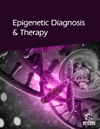Epigenetic Diagnosis & Therapy (Discontinued) - Current Issue
Volume 1, Issue 2, 2015
-
-
Epigenetic MicroRNA Regulation of Multiple Chromatin Functions: A Perspective in Cancer
More LessMicroRNAs (miRNAs) are a group of small noncoding RNAs of about 19-25 nucleotides (nt) in length. miRNAs act as a binary switch and play a key role in RNAi-mediated gene silencing by inhibiting translation and/or triggering subsequent degradation of their target mRNAs. Recent advances in the field of molecular biology have highlighted the role of miRNAs in different biological functions, including embryogenesis, developmen Read More
-
-
-
A Role for Epigenetics in Broadening the Scope of Pediatric Care in the Prevention of Adolescent Smoking
More LessAuthors: Steven R.H. Beach, Meg Gerrard, Frederick X. Gibbons, Gene H. Brody and Robert A. PhilibertAdolescence presents a critical opportunity to support the development of healthy patterns of behavior and prevent future health problems. Unfortunately, there is not yet a well-developed prevention model that allows pediatricians to initiate and monitor prevention efforts for the substantial minority of individuals who engage in risky behavior during adolescence. We suggest that recently developed epigenetic tech Read More
-
-
-
Epivention: Epigenetic Based Cancer Chemoprevention
More LessAuthors: Hui Wang, Jin Lu, Xiaoyong Tong, Xin Wang, Min Wang, Sufang Zhou, Zhenxiang An, Jinhua Wang and Wanzhou ZhaoThe new term "epivention" refers to epigenetic based cancer chemoprevention targeting epigenetic alterations caused by heritable, but potentially reversible, changes in DNA methylation and chromatin structure. Epigenetic alterations in cancer initiation, promotion, and progression stages, has gained increasing attention. Epigenetic alterations such as DNA methylation, histone modifications and microRNA play an important role Read More
-
-
-
The Role of Epigenetics in Drug Resistance in Cancer
More LessAuthors: Alexandra B. Lantermann, Kaitlin J. McCutcheon and Sreenath V. SharmaResistance of malignant cells to chemotherapy and molecularly targeted therapy is a major roadblock in our effort to cure cancer. A variety of underlying mechanisms have been described, some of which are shared between resistance to chemotherapy and resistance to molecularly targeted therapy. Although the influence of genetic mutations in the development of drug resistance is beyond question, many example Read More
-
-
-
Epigenetic Modulation: A Promising Avenue to Advance Hematopoietic Stem Cell-Based Therapy for Severe Autoimmune Disorders
More LessSevere autoimmune disorders, such as certain serious forms of multiple sclerosis, rheumatoid arthritis, and systemic lupus erythematosus, lead to poor prognosis for patients and can be fatal. Traditional immunosuppression therapies are rarely curative but only temporarily relieve patients from the flares. Arising “epigenetic” medications may enhance specificity but limitations still exist for their applications to severe autoimmune Read More
-
-
-
Do Chromatin Interaction Networks Radiate Pathogenic Contagion in the Genome?
More LessIt is being recognized that the eukaryotic genome physically interacts with itself via a complex network of long range chromatin interactions. While the insights to the underlying organizing principles are being worked out, an interesting and rather provocative theme which is emerging is that the genes can cross-talk to influence each others’ epigenetic states. If firmly established, this observation would endow a novel perspective Read More
-
-
-
Transcription Coupled DNA Methylation Mediated by RNA Pol II and DNMT1
More LessTranscriptional gene silencing is mediated by various epigenetic modifications including DNA methylation, histone modifications and recruitment of binding proteins that reads the methyl and other modification marks. The order in which these modifications occur followed by repressor protein recruitment remains contentious. Here, using purified protein components, we show that mammalian RNA polymerase II (RNA Pol II) is i Read More
-
Volumes & issues
Most Read This Month Most Read RSS feed
Article
content/journals/edt
Journal
10
5
false
en


